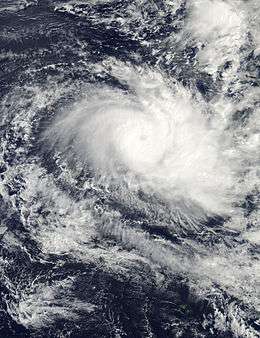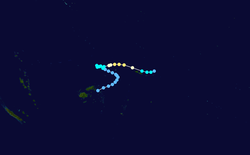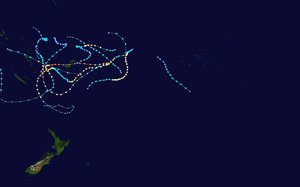Cyclone Amos
Severe Tropical Cyclone Amos was a strong tropical cyclone that affected the Fijian and Samoan Islands as well as Wallis and Futuna. Amos was first noted as Tropical Disturbance 17F during April 13, 2016 to the northwest of Fiji. The system subsequently moved south-eastwards towards the Fijian Islands, before it passed near or over Vanua Levu during April 16. After passing over Fiji, the system gradually developed further as it moved north-eastwards towards the Samoan Islands. The system was subsequently named Amos during April 20, after it had developed into a tropical cyclone and started to move north-westwards towards the island nation of Tuvalu.
| Category 3 severe tropical cyclone (Aus scale) | |
|---|---|
| Category 2 tropical cyclone (SSHWS) | |
 Cyclone Amos intensifying near Wallis and Futuna on April 22 | |
| Formed | April 13, 2016 |
| Dissipated | April 25, 2016 |
| Highest winds | 10-minute sustained: 150 km/h (90 mph) 1-minute sustained: 165 km/h (105 mph) |
| Lowest pressure | 965 hPa (mbar); 28.5 inHg |
| Areas affected | Fiji, Wallis and Futuna, Samoa, American Samoa |
| Part of the 2015–16 South Pacific cyclone season | |
Meteorological history

Tropical Disturbance 17F was first noted by the Fiji Meteorological Service on April 13, while it was located about 130 km (80 mi) to the northwest of the Fijian dependency of Rotuma.[1] The system was located underneath an upper level anticyclonic circulation and within an area of low vertical wind shear.[1] Over the next couple of days the system moved westwards, before it started moving south-eastwards towards Fiji during April 15.[2][3] The system was subsequently classified as a tropical depression on April 16, as passed near or over several islands in Fiji's Northern Division including Vanua Levu.[4][5] Over the next couple of days 17F moved north-eastwards towards the Samoan Islands and passed about 50 km (30 mi) to the west of Tonga's Niuas island group during April 18.[3][6] A tropical cyclone formation alert on the system was issued by the United States Joint Typhoon Warning Center during that day, as the well defined low level circulation centre consolidated.[7] The depression subsequently started to move north-westwards towards the island nation of Tuvalu, under the influence of a subtropical ridge of high pressure.[3][8] The system subsequently passed in between the islands of Wallis and Futuna, as a tropical depression during April 19.[3]
Early on April 20, the JTWC initiated advisories on the system and designated it as Tropical Cyclone 20P, while the system was located about 585 km (365 mi) to the west of Avata, Samoa.[9] Later that day, the FMS named the depression Amos, after the system had developed into a Category 1 tropical cyclone on the Australian tropical cyclone intensity scale.[10] However, further development of the system at this time was restricted by a trough of low pressure to the northeast of the system, which was causing subsidence over the systems north-eastern quadrant.[11] Amos subsequently slowed down later that day and became nearly stationary, as a near-equatorial ridge of high pressure became the primary steering mechanism.[11] As a result of this new primary steering mechanism, the system turned eastwards and moved towards the Samoan Islands.[11][12] As the system moved eastwards it started to rapidly intensify further, with an eye feature developing on microwave imagery.[13][14] Amos subsequently peaked as a Category 3 Severe Tropical Cyclone, with ten-minute sustained wind speeds of 150 km/h (90 mph) during April 22.[15] During that day as the cyclone passed within 120 km (75 mi) of Wallis Island, the JTWC estimated that Amos had peaked with 1-minute sustained winds of 165 km/h (105 mph).[16][17] Over the next day, the system remained at its peak intensity as it accelerated south-eastwards towards the Samoan Islands, where it was expected to pass over either Upolu or Tutuila.[14][17] Amos subsequently continued its south-eastwards movement and was thought to have passed very close to or over the Samoan Islands during April 23.[17][18][19] The system subsequently significantly weakened over the next day, as the circulation broke down and became sheared.[20] The system subsequently degenerated into a tropical disturbance during April 25, before it was last noted near American Samoa's Manuʻa Islands.[21]
Preparations and impact
| Precipitation | Storm | Location | Ref. | ||
|---|---|---|---|---|---|
| Rank | mm | in | |||
| 1 | 674.9 | 26.57 | Raja 1986 | Maopoopo, Futuna Island | [22] |
| 2 | 556.7 | 21.92 | Fran 1992 | Hihifo, Wallis Island | [22] |
| 3 | 291.2 | 11.46 | Val 1975 | Hihifo, Wallis Island | [22] |
| 4 | 220.6 | 8.69 | Hina 1997 | Maopoopo, Futuna Island | [22] |
| 5 | 186.0 | 7.32 | Evan 2012 | Futuna Island | [22] |
| 6 | 180.0 | 7.09 | Val 1980 | Maopoopo, Futuna Island | [22] |
| 7 | 171.6 | 6.76 | Keli 1997 | Hihifo, Wallis Island | [22] |
| 8 | 160.8 | 6.33 | Unnamed 1966 | Malaetoli, Wallis Island | [22] |
| 9 | 160.0 | 6.30 | Amos 2016 | Hihifo, Wallis Island | [23] |
| 10 | 119.0 | 4.69 | Waka 2001 | Hihifo, Wallis Island | [22] |
Severe Tropical Cyclone Amos affected the island nations of Fiji, Samoa and American Samoa, while the French Territory of Wallis and Futuna was also impacted.
Fiji
The precursor tropical disturbance to Cyclone Amos impacted Fiji between April 15–19, while the island nation was still recovering from the effects of Severe Tropical Cyclones Winston, Zena and Tropical Depressions 14F/15F.[4][24] As the system impacting the island nation, the Fiji Meteorological Service issued strong wind and heavy rain warnings, for the whole of the archipelago including Rotuma.[25][26] Flood warnings were also issued for parts of Vanua Levu including the Labasa, Qawa and Rakiraki Rivers and Labasa.[25][26] The disturbance subsequently passed near or over several islands, in Fiji's Northern Division including Vanua Levu during April 16.[4] The system brought several periods of heavy rain and strong winds to most of the Fijian Islands, with severe flooding reported on Vanua Levu during April 17.[4]
Wallis and Futuna
As Amos approached Wallis and Futuna, the Meteo-France NC issued an Alert 1 for the islands, which was later upgraded to an Alert 2. Amos was forecasted to bring winds of 120 km/h (75 mph) to 140 km/h (85 mph) with waves of four to six meters high.[27] Very heavy rains affected Wallis and Futuna as Amos made its closest approach to the islands. At the Hihifo Airport in Wallis, a rainfall measurement of 160 millimetres (6.3 in) was recorded.[23]
Samoa
Since Amos was forecast to hit Samoa as a Category 4 storm on April 24, emergency preparations went underway with water and generators being distributed. Amos was forecasted to bring sustained winds of 170 km/h (105 mph), with gusts as high as 220 km/h (135 mph) to Apia.[28] A total of 63 residents were evacuated prior to the storm. Despite the forecasts however, the impacts from Amos were not as severe as initially predicted. Amos hit the Samoan islands as a Category 3 storm, dropping between 100 millimetres (3.9 in) and 300 millimetres (12 in) of rain and bringing winds of up to 120 km/h (75 mph) to the islands. The most severe damage occurred in Savai'i where roads were damaged due to flooding. In addition, it is estimated that about 70 percent of the island nation lost electricity during the storm due to high winds.[29]
American Samoa
On April 23, the Joint Typhoon Warning Center issued forecasts that indicated that Amos would pass directly over American Samoa by April 24.[30] However, a recalculation in the storm position on April 24 altered the forecast track, sparing Pago Pago from a direct hit from Amos.[31] Amos brushed American Samoa to the north, dumping just over three inches of rain over Pago Pago. Amos was the strongest tropical cyclone to affect Samoa and American Samoa since Cyclone Evan in December 2012. Only three cyclones have tracked near American Samoa since 1959.[32]
See also
References
- RSMC Nadi — Tropical Cyclone Centre (April 13, 2016). "Tropical Disturbance Summary April 13, 2016 21z". Fiji Meteorological Service. Archived from the original on April 15, 2016. Retrieved April 23, 2016.
- "Significant Tropical Weather Advisory for the Western and South Pacific Oceans April 15, 2016". United States Joint Typhoon Warning Center. April 15, 2016. Archived from the original on April 16, 2016. Retrieved April 23, 2016.
- Fiji Meteorological Service (April 20, 2016). "Tropical Depression 17F midday update". Facebook. Retrieved April 23, 2016.
- Climate Services Division (May 6, 2016). Fiji Climate Summary: April 2016 (PDF) (Report). 37. Fiji Meteorological Service. Archived from the original (PDF) on May 8, 2016. Retrieved May 8, 2016.
- RSMC Nadi — Tropical Cyclone Centre (April 16, 2016). "Tropical Disturbance Summary April 16, 2016 09z". Fiji Meteorological Service. Archived from the original on April 16, 2016. Retrieved April 23, 2016.
- RSMC Nadi — Tropical Cyclone Centre (April 17, 2016). "Tropical Disturbance Summary April 17, 2016 09z". Fiji Meteorological Service. Archived from the original on April 18, 2016. Retrieved April 23, 2016.
- "Tropical Cyclone Formation Alert April 18, 2016 04z". United States Joint Typhoon Warning Center. April 18, 2016. Archived from the original on April 18, 2016. Retrieved April 24, 2016.
- RSMC Nadi — Tropical Cyclone Centre (April 19, 2016). "Tropical Disturbance Advisory April 19, 2016 12z". Fiji Meteorological Service. Archived from the original on April 21, 2016. Retrieved April 24, 2016.
- https://www.webcitation.org/6gvzM6Vbn?url=http://gwydir.demon.co.uk/advisories/WTPS31-PGTW_201604200300.htm
- RSMC Nadi — Tropical Cyclone Centre (April 20, 2016). "Tropical Disturbance Advisory April 20, 2016 12z". Fiji Meteorological Service. Archived from the original on April 21, 2016. Retrieved April 24, 2016.
- https://www.webcitation.org/6gvzKTej9?url=http://gwydir.demon.co.uk/advisories/WTPS31-PGTW_201604210300.htm
- https://www.webcitation.org/6gvzJmKT8?url=http://gwydir.demon.co.uk/advisories/WTPS31-PGTW_201604210900.htm
- https://www.webcitation.org/6gxdjsyEm?url=http://gwydir.demon.co.uk/advisories/WTPS31-PGTW_201604211500.htm
- https://www.webcitation.org/6gxdhu8FV?url=http://gwydir.demon.co.uk/advisories/WTPS31-PGTW_201604221500.htm
- RSMC Nadi — Tropical Cyclone Centre (April 22, 2016). "Tropical Disturbance Advisory April 22, 2016 12z". Fiji Meteorological Service. Archived from the original on April 22, 2016. Retrieved April 24, 2016.
- http://www.nrlmry.navy.mil/tcdat/tc16/SHEM/20P.AMOS/trackfile.txt
- https://www.webcitation.org/6gz5qIHXc?url=http://gwydir.demon.co.uk/advisories/WTPS31-PGTW_201604230900.htm
- https://www.webcitation.org/6h1GjdWZl?url=http://gwydir.demon.co.uk/advisories/FXZS60-NSTU_201604240215.htm
- https://www.webcitation.org/6h1Gobpqb?url=http://gwydir.demon.co.uk/advisories/FXZS60-NSTU_201604241956.htm
- https://www.webcitation.org/6h0rOucq9?url=http://gwydir.demon.co.uk/advisories/WTPS31-PGTW_201604240300.htm
- RSMC Nadi — Tropical Cyclone Centre (April 25, 2016). "Tropical Disturbance Summary April 25, 2016 12z". Fiji Meteorological Service. Archived from the original on April 27, 2016. Retrieved April 25, 2016.
- "Wallis and Futuna Cyclone Passes De 1880 à nos jours" [Wallis and Futuna Cyclone Passes From 1880 to the present day] (in French). Meteo France New Caledonia. Retrieved January 2, 2017.
- "Cyclone Amos: les Samoa ravagées" [Cyclone Amos: ravaged Samoa]. Meteo (in French). Retrieved April 24, 2016.
- "Archived copy" (PDF). Archived from the original (PDF) on 2016-06-17. Retrieved 2016-04-23.CS1 maint: archived copy as title (link)
- http://www.met.gov.fj/aifs_prods/TD17F_2.pdf
- http://www.met.gov.fj/aifs_prods/TD17F_3.pdf
- "Cyclone: Wallis en alerte rouge à l'approche d'Amos". Out-remer. Meteo-France NC. Retrieved 24 April 2016.
- "Direct hit predicted as Tropical Cyclone Amos intensifies on approach to Samoa's capital". ABC News. Retrieved 27 April 2016.
- Feagaimaalii-Luamanu, Joyetter. "After Amos: no casualties, no infrastructure damage reported in Samoa". Samoa News. Archived from the original on 27 April 2016. Retrieved 27 April 2016.
- Unisys Weather (April 23, 2016). "TROPICAL CYCLONE 20P (AMOS) WARNING NR 015". Joint Typhoon Warning Center. Archived from the original on May 12, 2016. Retrieved May 12, 2016.
- Unisys Weather (April 24, 2016). "TROPICAL CYCLONE 20P (AMOS) WARNING NR 017". Joint Typhoon Warning Center. Archived from the original on May 12, 2016. Retrieved May 12, 2016.
- Moore, Tom (April 24, 2016). "Tropical Cyclone Amos Brushes Samoa, American Samoa". The Weather Channel. Archived from the original on May 12, 2016. Retrieved May 12, 2016.
External links
| Wikimedia Commons has media related to Cyclone Amos. |
- World Meteorological Organization
- Australian Bureau of Meteorology
- Fiji Meteorological Service
- New Zealand MetService
- Joint Typhoon Warning Center
